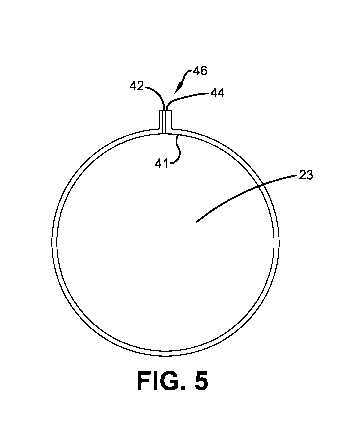Some of the information on this Web page has been provided by external sources. The Government of Canada is not responsible for the accuracy, reliability or currency of the information supplied by external sources. Users wishing to rely upon this information should consult directly with the source of the information. Content provided by external sources is not subject to official languages, privacy and accessibility requirements.
Any discrepancies in the text and image of the Claims and Abstract are due to differing posting times. Text of the Claims and Abstract are posted:
| (12) Patent Application: | (11) CA 3128011 |
|---|---|
| (54) English Title: | ATTACHMENT OF A FABRIC SLEEVE TO A COMMUNICATIONS CABLE |
| (54) French Title: | FIXATION D'UN MANCHON DE TISSU A UN CABLE DE COMMUNICATION |
| Status: | Examination |
| (51) International Patent Classification (IPC): |
|
|---|---|
| (72) Inventors : |
|
| (73) Owners : |
|
| (71) Applicants : |
|
| (74) Agent: | GOWLING WLG (CANADA) LLP |
| (74) Associate agent: | |
| (45) Issued: | |
| (86) PCT Filing Date: | 2020-01-15 |
| (87) Open to Public Inspection: | 2020-08-06 |
| Examination requested: | 2023-12-29 |
| Availability of licence: | N/A |
| Dedicated to the Public: | N/A |
| (25) Language of filing: | English |
| Patent Cooperation Treaty (PCT): | Yes |
|---|---|
| (86) PCT Filing Number: | PCT/US2020/013590 |
| (87) International Publication Number: | WO 2020159701 |
| (85) National Entry: | 2021-07-27 |
| (30) Application Priority Data: | |||||||||
|---|---|---|---|---|---|---|---|---|---|
|
An apparatus to be introduced into a conduit includes a cable and a fabric sleeve which extends longitudinally along the cable. The sleeve is secured around the cable by complimentary connectors which extend outwardly from the edges of the sleeve. The connectors can take the form of many configurations including a hook and slot, a ball and socket, a hook and loop, and zipper teeth, among others.
Un appareil à introduire dans un conduit comprend un câble et un manchon de tissu qui s'étend longitudinalement le long du câble. Le manchon est fixé autour du câble par des connecteurs complémentaires qui s'étendent vers l'extérieur depuis les bords du manchon. Les connecteurs peuvent prendre la forme de nombreuses configurations comprenant un crochet et une fente, une bille et une douille, un crochet et une boucle, et des dents de fermeture à glissière, entre autres.
Note: Claims are shown in the official language in which they were submitted.
Note: Descriptions are shown in the official language in which they were submitted.

2024-08-01:As part of the Next Generation Patents (NGP) transition, the Canadian Patents Database (CPD) now contains a more detailed Event History, which replicates the Event Log of our new back-office solution.
Please note that "Inactive:" events refers to events no longer in use in our new back-office solution.
For a clearer understanding of the status of the application/patent presented on this page, the site Disclaimer , as well as the definitions for Patent , Event History , Maintenance Fee and Payment History should be consulted.
| Description | Date |
|---|---|
| Letter Sent | 2024-01-08 |
| Request for Examination Requirements Determined Compliant | 2023-12-29 |
| All Requirements for Examination Determined Compliant | 2023-12-29 |
| Request for Examination Received | 2023-12-29 |
| Letter Sent | 2022-04-08 |
| Inactive: Multiple transfers | 2022-03-15 |
| Common Representative Appointed | 2021-11-13 |
| Inactive: Cover page published | 2021-10-14 |
| Letter sent | 2021-08-24 |
| Priority Claim Requirements Determined Compliant | 2021-08-19 |
| Application Received - PCT | 2021-08-19 |
| Inactive: First IPC assigned | 2021-08-19 |
| Inactive: IPC assigned | 2021-08-19 |
| Inactive: IPC assigned | 2021-08-19 |
| Inactive: IPC assigned | 2021-08-19 |
| Request for Priority Received | 2021-08-19 |
| Request for Priority Received | 2021-08-19 |
| Priority Claim Requirements Determined Compliant | 2021-08-19 |
| National Entry Requirements Determined Compliant | 2021-07-27 |
| Application Published (Open to Public Inspection) | 2020-08-06 |
There is no abandonment history.
The last payment was received on 2023-12-06
Note : If the full payment has not been received on or before the date indicated, a further fee may be required which may be one of the following
Please refer to the CIPO Patent Fees web page to see all current fee amounts.
| Fee Type | Anniversary Year | Due Date | Paid Date |
|---|---|---|---|
| Basic national fee - standard | 2021-07-27 | 2021-07-27 | |
| MF (application, 2nd anniv.) - standard | 02 | 2022-01-17 | 2021-12-29 |
| Registration of a document | 2022-03-15 | 2022-03-15 | |
| MF (application, 3rd anniv.) - standard | 03 | 2023-01-16 | 2022-12-13 |
| MF (application, 4th anniv.) - standard | 04 | 2024-01-15 | 2023-12-06 |
| Request for examination - standard | 2024-01-15 | 2023-12-29 |
Note: Records showing the ownership history in alphabetical order.
| Current Owners on Record |
|---|
| WESCO EQUITY CORPORATION |
| Past Owners on Record |
|---|
| JERRY L. ALLEN |